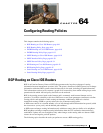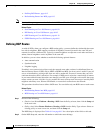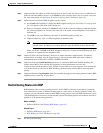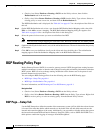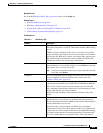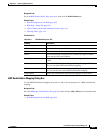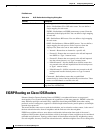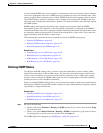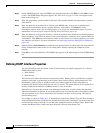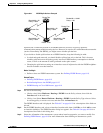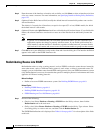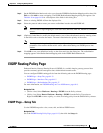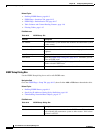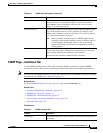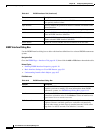
64-9
User Guide for Cisco Security Manager 4.4
OL-28826-01
Chapter 64 Configuring Routing Policies
EIGRP Routing on Cisco IOS Routers
A router running EIGRP stores all its neighbors’ routing tables so that it can quickly adapt to alternate
routes. If no appropriate route exists, EIGRP queries its neighbors to discover an alternate route. These
queries propagate until an alternate route is found. EIGRP sends incremental updates when the state of
a destination changes, instead of sending the entire contents of the routing table. EIGRP ensures that
only those routers needing the information are updated. This feature minimizes the bandwidth required
for EIGRP packets.
EIGRP supports both internal and external routes. Internal routes originate within an EIGRP
Autonomous System (AS). Therefore, a directly attached network that is configured to run EIGRP is
considered an internal route and is propagated with this information throughout the AS. External routes
are learned by another routing protocol or reside in the routing table as static routes. These routes are
tagged individually with the identity of their origin.
The following topics describe the tasks you perform to create an EIGRP routing policy:
• Defining EIGRP Routes, page 64-9
• Defining EIGRP Interface Properties, page 64-10
• Redistributing Routes into EIGRP, page 64-12
Related Topics
• Static Routing on Cisco IOS Routers, page 64-50
• RIP Routing on Cisco IOS Routers, page 64-42
• OSPF Routing on Cisco IOS Routers, page 64-19
• BGP Routing on Cisco IOS Routers, page 64-1
Defining EIGRP Routes
To configure an EIGRP routing policy, you must assign each autonomous system a number, which
identifies the autonomous system to other routers. You then must select the networks to which routes
will be created. In addition, you can select which interfaces should be passive. Unlike other routing
protocols, passive interfaces in EIGRP neither send nor receive routing updates from their neighbors,
resulting in the loss of their neighbor relationship.
When you configure EIGRP routing policies, you can also decide whether to enable auto-summarization,
which greatly simplifies routing tables and the exchange of routing information by having many subnets
represented by a single network entry.
Related Topics
• Defining EIGRP Interface Properties, page 64-10
• Redistributing Routes into EIGRP, page 64-12
• EIGRP Routing on Cisco IOS Routers, page 64-8
Step 1 Do one of the following:
• (Device view) Select Platform > Routing > EIGRP from the Policy selector, then click the Setup
tab in the work area.
• (Policy view) Select Router Platform > Routing > EIGRP from the Policy Type selector. Select
an existing policy or create a new one, and then click the Setup tab.
The EIGRP Setup tab is displayed (see EIGRP Page—Setup Tab, page 64-13).



